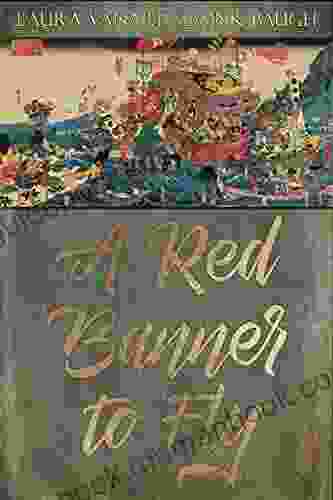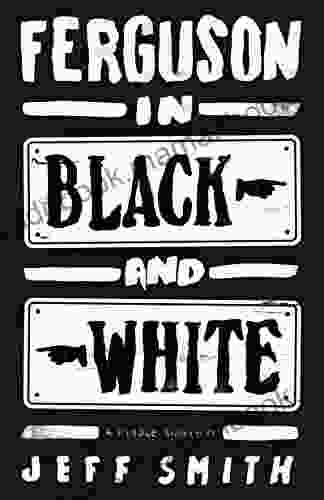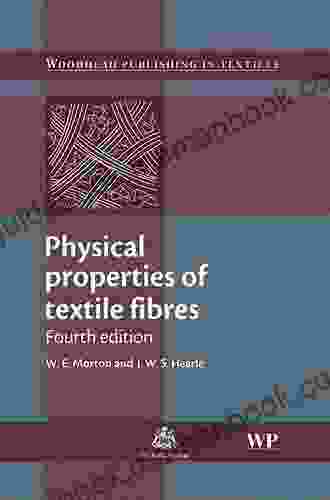Physical Properties of Textile Fibres

Textile fibres are the basic building blocks of fabrics. They are long, thin, and flexible, and they can be made from a variety of materials, including natural fibres (such as cotton, wool, and silk) and synthetic fibres (such as nylon, polyester, and spandex). The physical properties of textile fibres are important because they determine the performance of the fabrics made from them.
Textile Fibre Strength
The strength of a textile fibre is a measure of its resistance to breaking. It is important because it determines the ability of a fabric to withstand wear and tear. The strength of a textile fibre is affected by a number of factors, including the type of fibre, the fibre length, and the fibre diameter. Natural fibres are generally weaker than synthetic fibres, and shorter fibres are weaker than longer fibres. The diameter of a fibre also affects its strength, with finer fibres being weaker than coarser fibres.
5 out of 5
| Language | : | English |
| File size | : | 52464 KB |
| Text-to-Speech | : | Enabled |
| Screen Reader | : | Supported |
| Enhanced typesetting | : | Enabled |
| Print length | : | 796 pages |
Textile Fibre Elongation
The elongation of a textile fibre is a measure of its ability to stretch. It is important because it determines the comfort and fit of a fabric. The elongation of a textile fibre is affected by a number of factors, including the type of fibre, the fibre length, and the fibre diameter. Natural fibres generally have a higher elongation than synthetic fibres, and shorter fibres have a higher elongation than longer fibres. The diameter of a fibre also affects its elongation, with finer fibres having a higher elongation than coarser fibres.
Textile Fibre Moisture Regain
The moisture regain of a textile fibre is a measure of its ability to absorb moisture from the air. It is important because it determines the comfort and breathability of a fabric. The moisture regain of a textile fibre is affected by a number of factors, including the type of fibre, the fibre length, and the fibre diameter. Natural fibres generally have a higher moisture regain than synthetic fibres, and shorter fibres have a higher moisture regain than longer fibres. The diameter of a fibre also affects its moisture regain, with finer fibres having a higher moisture regain than coarser fibres.
Textile Fibre Thermal Conductivity
The thermal conductivity of a textile fibre is a measure of its ability to conduct heat. It is important because it determines the warmth of a fabric. The thermal conductivity of a textile fibre is affected by a number of factors, including the type of fibre, the fibre length, and the fibre diameter. Natural fibres generally have a lower thermal conductivity than synthetic fibres, and shorter fibres have a lower thermal conductivity than longer fibres. The diameter of a fibre also affects its thermal conductivity, with finer fibres having a lower thermal conductivity than coarser fibres.
Textile Fibre Electrical Conductivity
The electrical conductivity of a textile fibre is a measure of its ability to conduct electricity. It is important because it determines the electrical properties of a fabric. The electrical conductivity of a textile fibre is affected by a number of factors, including the type of fibre, the fibre length, and the fibre diameter. Natural fibres generally have a lower electrical conductivity than synthetic fibres, and shorter fibres have a lower electrical conductivity than longer fibres. The diameter of a fibre also affects its electrical conductivity, with finer fibres having a lower electrical conductivity than coarser fibres.
Textile Fibre Flammability
The flammability of a textile fibre is a measure of its ability to resist burning. It is important because it determines the fire safety of a fabric. The flammability of a textile fibre is affected by a number of factors, including the type of fibre, the fibre length, and the fibre diameter. Natural fibres generally have a higher flammability than synthetic fibres, and shorter fibres have a higher flammability than longer fibres. The diameter of a fibre also affects its flammability, with finer fibres having a higher flammability than coarser fibres.
The physical properties of textile fibres are important because they determine the performance of the fabrics made from them. By understanding the physical properties of textile fibres, manufacturers can design fabrics that meet the specific needs of their customers.
5 out of 5
| Language | : | English |
| File size | : | 52464 KB |
| Text-to-Speech | : | Enabled |
| Screen Reader | : | Supported |
| Enhanced typesetting | : | Enabled |
| Print length | : | 796 pages |
Do you want to contribute by writing guest posts on this blog?
Please contact us and send us a resume of previous articles that you have written.
 Top Book
Top Book Novel
Novel Fiction
Fiction Nonfiction
Nonfiction Literature
Literature Paperback
Paperback Hardcover
Hardcover E-book
E-book Audiobook
Audiobook Bestseller
Bestseller Classic
Classic Mystery
Mystery Thriller
Thriller Romance
Romance Fantasy
Fantasy Science Fiction
Science Fiction Biography
Biography Memoir
Memoir Autobiography
Autobiography Poetry
Poetry Drama
Drama Historical Fiction
Historical Fiction Self-help
Self-help Young Adult
Young Adult Childrens Books
Childrens Books Graphic Novel
Graphic Novel Anthology
Anthology Series
Series Encyclopedia
Encyclopedia Reference
Reference Guidebook
Guidebook Textbook
Textbook Workbook
Workbook Journal
Journal Diary
Diary Manuscript
Manuscript Folio
Folio Pulp Fiction
Pulp Fiction Short Stories
Short Stories Fairy Tales
Fairy Tales Fables
Fables Mythology
Mythology Philosophy
Philosophy Religion
Religion Spirituality
Spirituality Essays
Essays Critique
Critique Commentary
Commentary Glossary
Glossary Bibliography
Bibliography Index
Index Table of Contents
Table of Contents Preface
Preface Introduction
Introduction Foreword
Foreword Afterword
Afterword Appendices
Appendices Annotations
Annotations Footnotes
Footnotes Epilogue
Epilogue Prologue
Prologue Luchrisa Valentine
Luchrisa Valentine Patricia Burch
Patricia Burch Stacy Kestwick
Stacy Kestwick Philip Hobsbaum
Philip Hobsbaum Nancy F Koehn
Nancy F Koehn Mark Nelson O Brien
Mark Nelson O Brien Thomas Nelson Page
Thomas Nelson Page Tracy Yates
Tracy Yates John Currence
John Currence Susan Elia Macneal
Susan Elia Macneal Brom
Brom Joseph J Ellis
Joseph J Ellis Paul French
Paul French Reds Johnson
Reds Johnson Nicole Snow
Nicole Snow Jeremy A Henry
Jeremy A Henry Paul Bloom
Paul Bloom Alexander Phenix
Alexander Phenix Zbigniew Herbert
Zbigniew Herbert Joseph Bottum
Joseph Bottum
Light bulbAdvertise smarter! Our strategic ad space ensures maximum exposure. Reserve your spot today!

 Avery SimmonsThe Big Bad Mary McCarthy Prize in Short Fiction: A Deep Dive into Literary...
Avery SimmonsThe Big Bad Mary McCarthy Prize in Short Fiction: A Deep Dive into Literary...
 Davion PowellWhat Lies Ahead For The Business Of Luxury: Exploring Emerging Trends and...
Davion PowellWhat Lies Ahead For The Business Of Luxury: Exploring Emerging Trends and... Hunter MitchellFollow ·18.5k
Hunter MitchellFollow ·18.5k Julian PowellFollow ·18.4k
Julian PowellFollow ·18.4k Brody PowellFollow ·16.7k
Brody PowellFollow ·16.7k Rodney ParkerFollow ·12.5k
Rodney ParkerFollow ·12.5k Jorge AmadoFollow ·8.4k
Jorge AmadoFollow ·8.4k Leo TolstoyFollow ·18k
Leo TolstoyFollow ·18k Fernando BellFollow ·14.1k
Fernando BellFollow ·14.1k Eliot FosterFollow ·8.9k
Eliot FosterFollow ·8.9k

 Leslie Carter
Leslie CarterWhat We Must Do Now To Save Reproductive Freedom
Roe v. Wade, the landmark...

 Cade Simmons
Cade SimmonsThe Unbreakable Bond: Unveiling the Connection Between...
In the realm of...

 Roy Bell
Roy BellFull Contact Chapter Five: The Final Chapter of the Hatch...
In this gripping to the Hatch saga, we...

 Fred Foster
Fred FosterUnveiling the Tale of the Genpei Wars: A Comprehensive...
Deep within the annals of Japanese history,...

 Jaden Cox
Jaden CoxFerguson in Black and White: A Profound Examination of...
The Ferguson tragedy, sparked by the fatal...
5 out of 5
| Language | : | English |
| File size | : | 52464 KB |
| Text-to-Speech | : | Enabled |
| Screen Reader | : | Supported |
| Enhanced typesetting | : | Enabled |
| Print length | : | 796 pages |










